About Dimensioning in 2D Layout for 3D Design | ||
| ||
General Information Regarding Dimensioning in 2D Layout for 3D Design
This sub-topic provides general information regarding dimensioning in 2D Layout for 3D Design.
The 2D Layout for 3D Design workbench enables you to create:
- 2D dimensions (measured or driving)
- associative 3D dimensions (measured only)
- associative hybrid dimensions between 2D and 3D elements (measured only)
As dimensioning commands work as in the Interactive Drafting workbench, most tasks included in the Working with Dimensions and About Dimension Systems sections provide links to the Interactive Drafting User's Guide. However, there are a few particularities about dimensioning in 2D Layout for 3D Design, as opposed to doing so in Interactive Drafting, which you will learn in this section.
![]()
Selecting Elements To Dimension
This sub-topic provides information on selecting the elements to dimension.
Dimension commands provide a visual feedback indicating whether it is possible to create dimensions on a given element.
However, you should be aware of the following rule: in a given 3D shape layout, it is impossible to create a dimension for another 3D shape. You can only create dimensions within a single 3D shape layout. For example, in Part.1, it is not possible to store a dimension measuring an element of Part.2.
When selecting elements to dimension, remember the following points:
- Dimensions can be created in any view, even a non-active one.
- After starting a dimension command, the view in which you select the first element is the view of creation (that is the view where the dimension will be created).
- You can always select an element belonging to the view content.
- Once you have selected the first element, you can only select the other elements in the view of creation.
- You cannot select as the first element a 2D background element.
- You can select an element which belongs to the 3D background of a 3D shape layout only if this element belongs to the current layout.
![]()
Dimensioning: Use Cases
The following sub-topics are discussed:
- Dimension on view content
- Dimension on 2D background
- Dimension on 3D background
- Dimension on view content and 2D background
- Dimension on view content and 3D background
- Dimension on 2D background and 3D background
Dimension on view content
Such dimensions can have 1, 2 or 3 reference elements which are either 2D geometry or dress-up. They behave exactly as they do in the Interactive Drafting workbench.
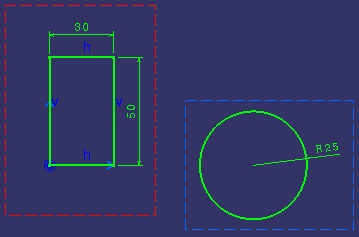
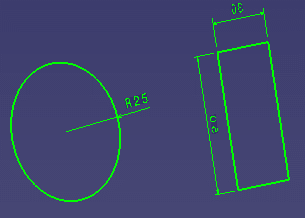
The table below provides additional information about dimension on view content:
| Dimension on view content | |
|---|---|
| Available dimensions | Distance, offset, length, curvilinear length, circular length, angle, radius, diameter, chamfer, thread, coordinate, chained, cumulated, stacked |
| Not-supported dimensions | True length |
| Available dimension type | Measured, driving (view content element) |
Dimension on 2D background
Dimensions on 2D background (that is with reference elements belonging exclusively to the 2D background) are not supported.
Dimension on 3D background
Such dimensions have reference elements which belong exclusively to the 3D background.
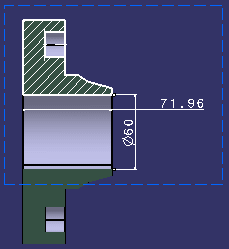
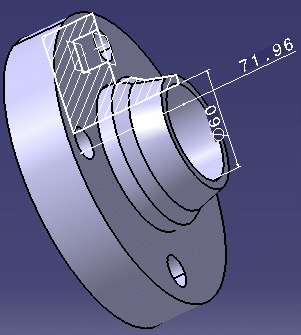
The table below provides additional information about dimension on 3D background:
| Dimension on view content | |
|---|---|
| Available dimensions | Distance, length, curvilinear length, circular length, angle, radius, diameter, chamfer, chained, cumulated, stacked |
| Available dimension type | Measured |
| Update | There is no automatic update. After a modification on the 3D geometry, the corresponding dimension must be updated with the layout, sheet or view. Note that before update, the views are not seen as being "not up to date" |
Dimension on view content and 2D background
Such dimensions have two reference elements which are either 2D geometry or dress-up. Both reference elements (the one in the view content and the one in the 2D background) belong to the same 3D shape layout.
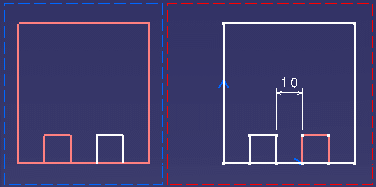
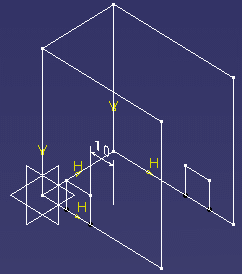
The table below provides additional information about dimension on view content and 2D background:
| Dimension on view content | |
|---|---|
| Available dimensions | Distance, angle |
| Available dimension type | Measured |
Dimension on view content and 3D background
Such dimensions have two reference elements, one of which is either 2D geometry or dress-up, while the other is a 3D element (edge, 3D wireframe). Both reference elements (the one in the view content and the one in the 3D background) belong to the same 3D shape layout.
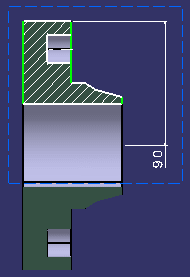
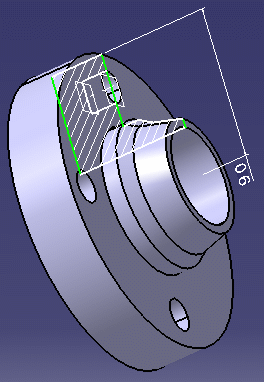
The table below provides additional information about dimension on view content and 3D background:
| Dimension on view content | |
|---|---|
| Available dimensions | Distance, angle |
| Available dimension type | Measured |
![]()
Dimensioning: Particular Cases
The following sub-topics are discussed:
Dimension systems
Dimensions individually behave as classical dimensions. For example, you can create a cumulated dimension system by selecting first an element in the view content (that is the reference), and then elements either in the view content, 2D background or 3D background. However, if the reference is a 2D background element, then the other elements must belong to the view content.
![]()
Before You Begin Creating Dimensions in 2D Layout for 3D Design
Before you begin creating dimensions in 2D Layout for 3D Design, make sure you are familiar with the concepts listed below.
- The Tools toolbar and the Tools Palette. For more information, refer to Using Layout Tools.
- SmartPick, an easy-to-use tool designed to assist you when creating dimensions. For more information, refer to Using SmartPick.
- Multi-selection. For more information, refer to the Infrastructure User's Guide: Selecting Objects.